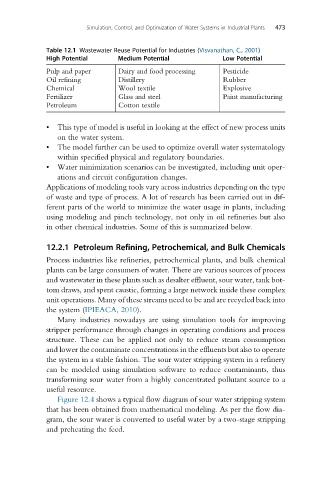Page 503 - Industrial Wastewater Treatment, Recycling and Reuse
P. 503
Simulation, Control, and Optimization of Water Systems in Industrial Plants 473
Table 12.1 Wastewater Reuse Potential for Industries (Visvanathan, C., 2001)
High Potential Medium Potential Low Potential
Pulp and paper Dairy and food processing Pesticide
Oil refining Distillery Rubber
Chemical Wool textile Explosive
Fertilizer Glass and steel Paint manufacturing
Petroleum Cotton textile
• This type of model is useful in looking at the effect of new process units
on the water system.
• The model further can be used to optimize overall water systematology
within specified physical and regulatory boundaries.
• Water minimization scenarios can be investigated, including unit oper-
ations and circuit configuration changes.
Applications of modeling tools vary across industries depending on the type
of waste and type of process. A lot of research has been carried out in dif-
ferent parts of the world to minimize the water usage in plants, including
using modeling and pinch technology, not only in oil refineries but also
in other chemical industries. Some of this is summarized below.
12.2.1 Petroleum Refining, Petrochemical, and Bulk Chemicals
Process industries like refineries, petrochemical plants, and bulk chemical
plants can be large consumers of water. There are various sources of process
and wastewater in these plants such as desalter effluent, sour water, tank bot-
tom draws, and spent caustic, forming a large network inside these complex
unit operations. Many of these streams need to be and are recycled back into
the system (IPIEACA, 2010).
Many industries nowadays are using simulation tools for improving
stripper performance through changes in operating conditions and process
structure. These can be applied not only to reduce steam consumption
and lower the contaminate concentrations in the effluents but also to operate
the system in a stable fashion. The sour water stripping system in a refinery
can be modeled using simulation software to reduce contaminants, thus
transforming sour water from a highly concentrated pollutant source to a
useful resource.
Figure 12.4 shows a typical flow diagram of sour water stripping system
that has been obtained from mathematical modeling. As per the flow dia-
gram, the sour water is converted to useful water by a two-stage stripping
and preheating the feed.

